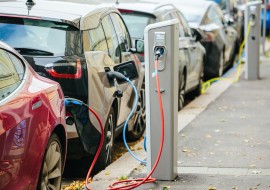The utility business model—the method by which regulated utilities (e.g., electricity or natural gas utilities) recover their costs and can earn a return through rates charged to their customers—can impact whether a utility chooses to invest in successful energy efficiency programs. Traditional business models that prioritize increasing sales and infrastructure investment can create a disincentive for utilities to offer energy efficiency. To address this, many states have passed reforms such as revenue decoupling and performance incentives that address these challenge.
Conventional Utility Business Model
Under traditional regulation, utility revenues are based on sales: the more energy a utility sells, the more revenue it earns. The rates that a utility charges to customers are set by regulators, based on the utility’s annual revenue requirement (a combination of investments, an approved rate of return, and fixed operation costs). Utilities earn a profit by investing in capital expenses, such as new power plants, transmission and distribution infrastructure, and recovering those costs through rates, plus an approved rate of return on investment. Utilities also have fixed costs that may not be fully recovered when kWh sales fall. Energy efficiency decreases sales by reducing the amount of energy customers use, and it tends to be treated as an operational rather than capital expense, motivating utilities to oppose efficiency. Regulatory reform can address these issues and align utility interests with those of their customers.
Revenue Decoupling: Decoupling Utility Profits from Sales
Revenue decoupling means that a utility’s revenues are dissociated from its sales. This allows utilities to freely invest in energy efficiency programs without impacting the utility’s bottom line, enabling lower rates over the long term. There are several regulatory mechanisms that achieve this result, but all decoupling mechanisms work by periodically (monthly, quarterly, or annually, for example) comparing the commission-authorized revenue and the actual revenue. Customers see a surcharge when sales are lower than expected, and a refund when sales are higher than expected.
Financial Incentives for Efficiency
While revenue decoupling removes the disincentive for utilities to implement energy efficiency, on its own it does not address the bias to invest in capital assets such as new power plants and infrastructure over labor or expenses. As a result, states that want to encourage utilities to expand energy efficiency programs and savings will need to establish performance incentive mechanisms that offer a financial reward based on achieving certain policy goals related to energy efficiency, such as energy savings, demand reduction, net benefits, or greenhouse gas reductions.
Such performance incentives can be structured so that the utility earns a share of the net benefits from efficiency investments, while others provide a cash reward for meeting energy savings or other targets. In addition, some utilities earn a rate of return on their efficiency spending, as they would for investments in generation or transmission and distribution infrastructure; these incentives can also be aligned with performance criteria.
Learn More
- Find out which states have enacted revenue decoupling and/or offer energy efficiency incentives in ACEEE’s State Energy Efficiency Policy Database.
- For detailed information on federal and state financial incentives, visit the Database of State Incentives for Renewables and Efficiency (DSIRE).
Highlighted Resources
Contact Info
For more information or to contact a researcher, please visit the utilities program.









